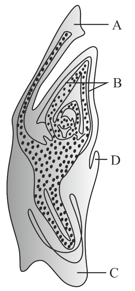Embibe Experts Solutions for Chapter: Sexual Reproduction in Flowering Plants, Exercise 4: Exercise-4
Embibe Experts Biology Solutions for Exercise - Embibe Experts Solutions for Chapter: Sexual Reproduction in Flowering Plants, Exercise 4: Exercise-4
Attempt the practice questions on Chapter 24: Sexual Reproduction in Flowering Plants, Exercise 4: Exercise-4 with hints and solutions to strengthen your understanding. Alpha Question Bank for Medical: Biology solutions are prepared by Experienced Embibe Experts.
Questions from Embibe Experts Solutions for Chapter: Sexual Reproduction in Flowering Plants, Exercise 4: Exercise-4 with Hints & Solutions
Upon fertilization what structure develops from carpel?
Emasculation is not required when flowers:are
How many haploid nuclei are present in a mature pollen grain?
Identify the parts labelled A, B, C and D in the given figure and select the correct option.

Ploidy level of nucellus, endosperm polar nuclei, megaspore mother cell, female gametophyte respectively are
Albuminous seeds are found in-
Which of the following is false fruit?
In somatic hybridization of leaf and nucellus cells of pinus, the ploidy level is
